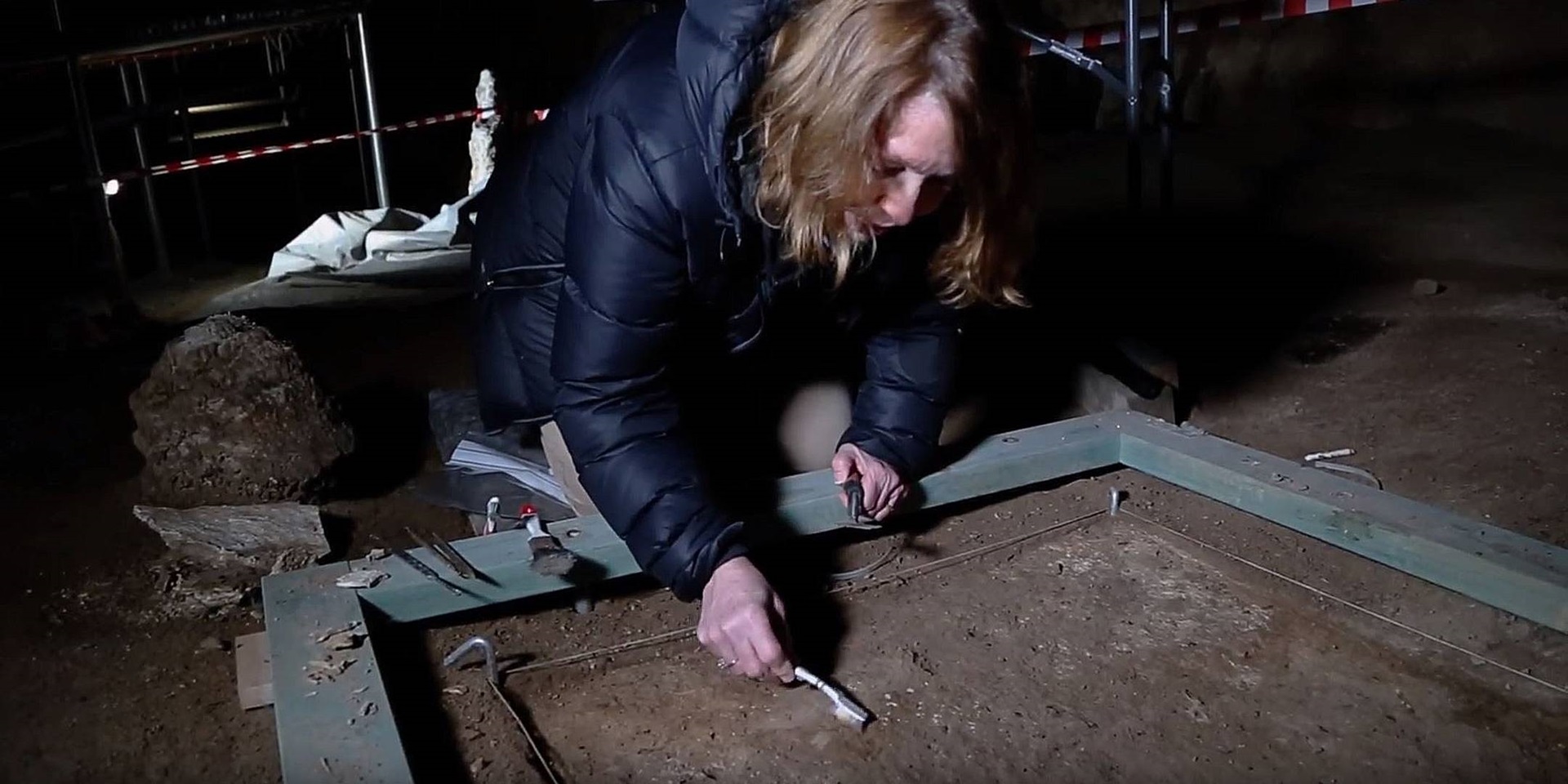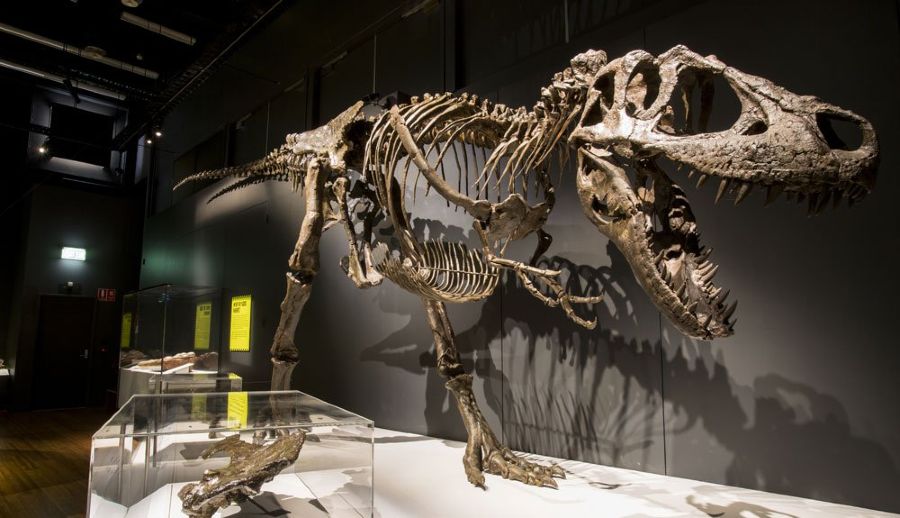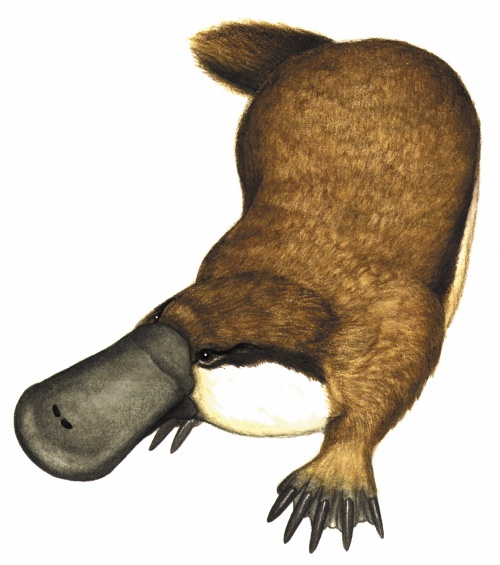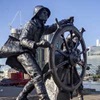
In this week's Ocean Talk, paleontologist Dr Anne Musser will be battling it out with Dr Colin McHenry over who should be crowned killer king of the cretaceous: the T-Rex or Sea-Rex?
Before these two experts go head-to-head, we sat down with Dr Anne Musser to uncover what she does, what's the best thing about her job, and who should be crowned the ultimate prehistoric predator.
1. Who are you and what do you do?
I do a lot of different things! I am a vertebrate paleontologist, and I've worked on all sorts of things, mostly I'm a mammal paleontologist, but I've worked on dinosaur exhibitions and galleries.
I've been with the Australian Museum since 1998, sometimes as an employee sometimes as I am now, as an Honorary Research Associate. So the last big project I did with them was Tyrannosaurs – Meet the Family, which I'm very proud of and was a lot of fun. This was a major exhibition and it's actually still going! It's in the National Museum of Scotland at the moment.

Cast skeleton of a Tyrannosaur from the Australian Museum's exhibition, Tyrannosaurs – Meet the Family which Anne worked on. Image courtesy Australian Museum
I also work at Jenolan Caves as a guide and as a paleontologist, exploring the caves for bones. I'm currently excavating small bones that have been collecting under an old owl roost which is really quite exciting. I've identified an Ice Age megafauna, a Zygomaturus, that was found in the 1800s but it wasn't properly identified. I've confirmed the identity of a short-faced kangaroo as well. We have a nice range of prehistoric animals at Jenolan, and they're similar but also different to the range of animals we have now. Some of the same animals have been here for millions of years, but a lot of the megafauna and the unique animals from the Ice Age and earlier – just aren't here anymore.
And then I also do bio-survey work which is very dear to me and something that I've been doing for the last 10 years. I go out with my camera every lunch, and see what animals I can see and what animals I can record on site. This has been very interesting because Jenolan has fantastic fauna of some threatened rare species.
So yeah ... I'm pretty busy!
2. When did your passion for prehistoric creatures begin?
I always loved animals, especially horses when I was a little girl – but I was interested in living animals. I didn't think about paleontology until I was offered an anatomy project while I was doing my Masters of Systematics and Ecology at the University of Kansas. A paleontologist there said to me, 'We have an echidna in the freezer from the zoo, would you like to work on that?' And I said 'Why not?' and that's how it started.
So then I ended up getting a Fulbright Grant, came out to Australia and then I was offered a PhD project at the University of New South Wales on platypus and echidna's prehistoric ancestors, and then I got into pre-history and that's when I went 'Yeah, this is really interesting'.
3. What's the best thing about your job?
Oh gosh, where to start! A lot of what I do (the paleontology and bio-survey work at Jenolan) is actually done as a volunteer, so my paid work is actually working as a guide in the caves which I love. But the whole package is very enriching – it's a wonderful thing to think something through, to maybe be the first person to come up with an idea and to also breathe life into these creatures.
I've done a lot of fossil reconstructions and that's a lot of fun, seeing what these animals might have looked like. You put it back together with the knowledge of what we know now, what I know from where I work, what I have read, etc – it's just a really sort of transformative experience to put that through your brain and see what might have been.
4. What's something about your work that would surprise people?
That you can tell so much once you know anatomy and once you know living animals. That you get to where you feel like you can read the bones, and it does surprise you how accurate you can be if you've got the right background and you take the time.
5. What are you currently working on?
I am currently working on three main projects. I am working on early mammals from the Mesozoic of Australia, which include early monotremes (the ancestors of today's platypus and echidnas) along with other new species (yet to be named!) I am also working on later monotremes, like the ancient Riversleigh platypus Obdurodon. In order to understand monotremes and their Australian relatives, you need to travel outside of Australia, since the early mammals most closely related to monotremes have been found outside of Australia in places like Europe and North America. I am also working on the fossil animals of Jenolan Caves as we've discussed, which should prove to be very interesting.

Obdurodon dicksoni, the large spoon-billed platypus from the Riversleigh area of northern Australia. Image courtesy Dr Anne Musser
6. What's been your career highlight to date?
Working on a most mysterious animal, Kollikodon ritchiei from the Cretaceous of Lightning Ridge in New South Wales. This strange near-mammal was thought to be a monotreme, like other fossils from the area, but I believe it comes from a much different group, one that is much older than the monotremes (which are themselves very ancient!) I hope to have a paper soon with my co-authors, so watch this space!
7. How does studying these ancient creatures and their fossils help the world today?
For the Mesozoic period which is your dawn of mammals and the days of the dinosaurs, I think it's incredibly important to know that we have types of animals from that period that are still with us, like platypuses, lungfishes and crocodiles, etc. As our world is rapidly changing, we need to try and hold onto these incredible messengers from the past as they're still with us. What can they tell us about how they've survived and how they've adapted? How they've specialised to live in this incredible continent?
With the animals in the Ice Age and the ones that are from Jenolan, there's been so many changes and a lot of things have been lost. Why don't we have some of the animals from the recent past? We haven't got bandicoots here anymore, but I found them in the owl pellet digs. Why don't we have megafauna here anymore? Why don't we have a short-faced kangaroo anymore? Things have changed, the groups of animals have come and gone.
There's been a lot of pressure since European settlement particularly, and we've lost a lot of mammal species, and the hope is that we don't keep losing them. And this is what we can learn for the future – that they can go and they can go quickly.
8. What dinosaurs or marine reptiles do you think were the scariest?
T-Rex was much scarier than any marine reptile! Every year, more and more information comes out about what an incredible animal it was. The T-Rex ended up with these almost like super powers: it had this incredible combination after 100 million years of evolution. It had an incredible sense of smell, almost like a sixth-sense, it had intelligence, it had strength with its huge limbs, great eyesight and it was a killing machine with those teeth!
Other theropods and marine reptiles have something special, but I'm betting on the T-Rex here.
9. What's your favourite prehistoric creature?
Well I have really gotten to know the T-Rex quite well, and I also have to say I'm very fond of the fossil platypus Obdurodon. If you want a Yin and a Yang, you can't go past a T-Rex and a platypus could you? I'll put them on equal pedastals.
10. I think I already know your answer (but I'll ask anyways), who would win: T-Rex or Sea-Rex?
I gotta fly the flag for the T-Rex! Marine reptiles were lucky they lived in the water because if they met up with a T-Rex, they would have ended up sitting on the sea floor, mouldering away, being picked at by crabs.
Want to hear more from Dr Anne Musser and what dinosaurs and marine reptiles were the scariest? Who had the biggest bite? Be sure to attend our Ocean Talk so you find out for yourself and learn more about these ferocious predators, how we study them and what we've learnt.
